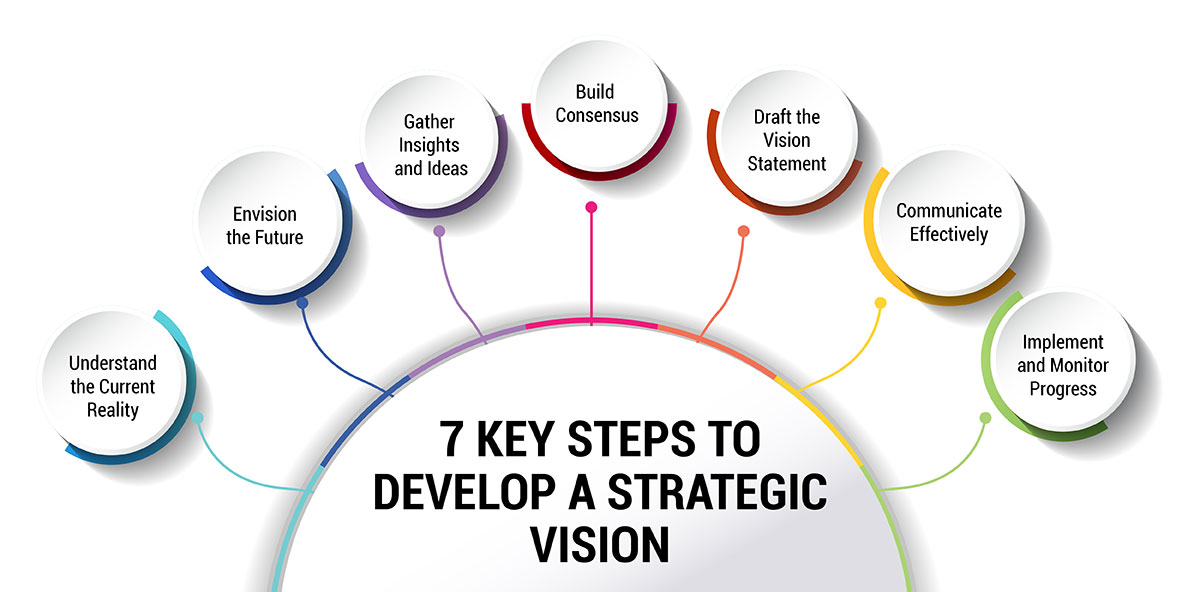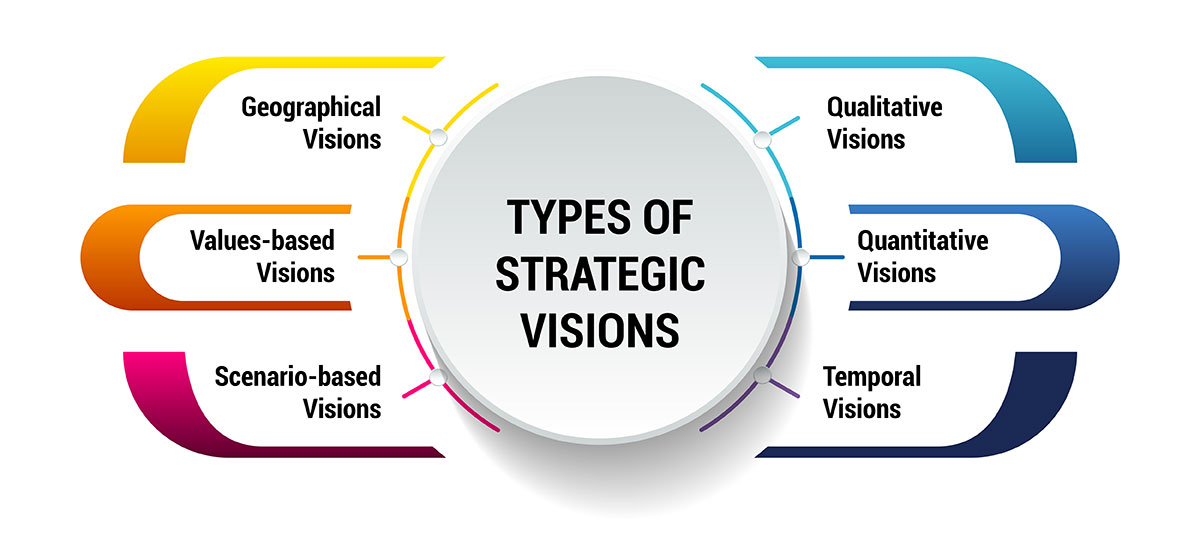Strategic Vision: A Guide for Developing a Clear Roadmap for Your Organization
 September 11, 2024
September 11, 2024
A strategic vision provides guidance and inspiration by depicting where an organization aims to be in the future. It helps align teams and functions to work towards common strategic objectives and serves as a compass for decision-making. Developing a clear strategic vision requires understanding organizational goals, assessing the market environment, identifying strategic issues, crafting the vision statement, and effective communication. This comprehensive guide will help you create a strategic vision for your company.
What is a Strategic Vision?
A strategic vision refers to the desired future state of an organization. It focuses on where the organization aims to be in the long run, usually 3 to 10 years, in terms of its impact, scale, and performance. A strategic vision inspires stakeholders by conveying a compelling and aspirational future while also providing guidance for decision-making,
business strategy formulation, and resource allocation.
Some key aspects of a strategic vision include:
-
Long-term focus: It outlines goals and aspirations for the future rather than immediate operational plans.
-
Forward-looking: A strategic vision anticipates trends, opportunities, and challenges to chart a path for future success.
-
Inspiring: It conveys a desirable future state in a way that motivates stakeholders to work towards realizing that vision.
-
Guiding: It serves as a framework to align strategies, plans, and decisions with the organization's long-term objectives and values.
-
Inclusive: Developing the vision through collaborative efforts helps build consensus and commitment across the organization.
Thus, a good strategic vision statement depicts the desired long-term outcomes while also acting as a compass for the organization's journey ahead.
Why a Strategic Vision is Essential for Growth of your Organization
A well-articulated strategic vision brings clarity and focus to an organization. It helps in:
-
Providing Direction: A clear future vision helps structure strategies and priorities to work towards well-defined long-term goals.
-
Inspiring Stakeholders: Communicating a compelling future vision motivates employees and fosters commitment to organizational success.
-
Strategic Agility: Anticipating trends enables timely decision-making and adapting strategies according to market shifts.
-
Performance Management: Goals in the vision can be broken down to measure progress at various levels within the organization.
-
Resource Allocation: Capital and investments can be judiciously deployed to strategies aligned with the vision.
-
Building Unity: Developing the vision collaboratively promotes consensus and cooperation across functions.
-
Sustained Growth: Pursuing an ambitious long-term vision supports innovations for enduring competitive advantage.
-
Attracting Talent: An aspirational vision helps recruit and retain the best talent inspired by the organization's purpose.
Thus, crafting a strategic vision acts as a compass guiding continuous progress towards important objectives.
Steps to Develop a Strategic Vision
The process of developing a strategic vision involves understanding the current realities, envisioning the future, gathering insights, building consensus, and effective communication. Here are the key steps:

1. Understand the Current Reality
The first step is to understand the organization's current context, capabilities, and environment. This includes:
-
Reviewing the organizational context such as the mission, values, resources and capabilities. It is important to have a clear understanding of why the organization exists and what it is capable of.
-
Conducting a PESTEL (Political, Economic, Social, Technological, Environmental, Legal) analysis to assess the macro external factors influencing the industry and organization.
-
Performing a
SWOT (Strengths, Weaknesses, Opportunities, Threats) analysis to identify the core strengths to leverage, areas for improvement, potential opportunities for growth, and threats in the external environment.
-
Analyzing the competitive landscape and position relative to peers through techniques like Porter's Five Forces. This helps identify the strategic issues and challenges to address.
The outcome of this step is a holistic understanding of the organization's current strengths and weaknesses as well as opportunities and threats in the external environment. This forms the baseline for envisioning the future.
2. Envision the Future
With an understanding of the present, the next step is to envision various future scenarios and define the desired future state. This involves:
-
Brainstorming with leadership and cross-functional teams on the long-term strategic outcomes, scope of impact, and aspirational goals keeping in mind the opportunities and threats identified.
-
Forecasting trends to envision plausible future scenarios over the next 5-10 years considering technological advancements, disruptions, customer and market evolutions, and regulatory changes.
-
Defining the envisioned future state both qualitatively in terms of strategic advantages, differentiating capabilities and impacts as well as quantitatively through specific goals, targets and metrics.
-
Envisioning multiple future scenarios to identify pathways for achieving the defined future state despite uncertainties.
3. Gather Insights and Ideas
To refine the strategic vision, insights are gathered from both internal and external stakeholders. This can be done by:
-
Conducting employee and customer interviews/surveys to understand diverse perspectives and aspirations.
-
Benchmarking vision and organization strategy of leading organizations in the industry to identify best practices.
-
Engaging with design, product, and innovation teams to sketch creative prototypes of envisioned future capabilities, experiences, and business models.
-
Discussions with technology providers and academic experts to foresee emerging trends and solutions.
4. Build Consensus
To ensure organizational buy-in, it is important to build consensus on the strategic vision. This involves:
-
Socializing early vision concepts with senior leadership and cross-functional teams to gather their feedback, refine ideas, and address concerns.
-
Hosting strategic visioning workshops with representatives from different departments to incorporate diverse viewpoints and reach a common understanding of the strategic direction.
-
Presenting the proposed strategic vision to the Board of Directors to gain their formal approval and commitment to the new strategic path.
5. Draft the Vision Statement
With insights gathered and consensus built, the next step is to draft the vision statement itself. The key aspects are:
-
Keeping it simple, inspiring and easily understandable to appeal to diverse stakeholders.
-
Focusing on the aspirational future state rather than current realities or constraints.
-
Incorporating quantitative goals, core values, strategic advantages and desired qualitative impacts.
-
Limiting it to no more than one short paragraph or a few concise single sentences.
6. Communicate Effectively
Once drafted, effective communication is critical to socialize the vision across the organization. This involves:
-
Cascading town hall-style presentations and follow-up dialogues to socialize the vision and ensure understanding.
-
Linking strategies, objectives, initiatives and OKRs back to the vision during key planning and review discussions.
-
Periodically communicating through multiple channels like emails, posters and intranet to constantly reinforce the vision.
7. Implement and Monitor Progress
The final steps involve implementing initiatives aligned with the vision and tracking progress:
-
Cascading the vision into functional and individual level strategies, plans, OKRs and KPIs.
-
Tracking key lead indicators to iteratively refine strategies based on learnings and ensure progress.
-
Reviewing the vision periodically along with achievements and new realities to reassess and update for continued relevance.
Developing an effective strategic vision is an iterative process involving understanding, envisioning, gathering insights, building consensus, communicating and implementing - all aimed at steering long-term organizational success.
Types of Strategic Visions
Organizations can develop strategic visions focusing on different aspects based on their context and objectives. Here are some common types:

-
Qualitative Visions: Focus on intangible factors like reputation, customer experience, innovation leadership etc. rather than numbers.
-
Quantitative Visions: Incorporate specific numeric targets for financials, market share, productivity or other measurable parameters.
-
Temporal Visions: Depict a desired state to be achieved by a defined timeline like becoming number 1 in 5 years.
-
Geographical Visions: Center around expanding globally, penetrating new territories or serving a broader region.
-
Values-based Visions: Revolve around principles of conduct like ethics, sustainability or social responsibility.
-
Scenario-based Visions: Portray a future environment the organization wishes to create like a pollution-free world.
Most effective visions weave together both qualitative and quantitative dimensions to outline a compelling direction.
Examples of Impactful Strategic Visions
Let's analyze how leading organizations have effectively articulated strategic visions to guide their journeys:
-
Amazon - Earth's most customer-centric company
Amazon's vision conveys its unwavering focus on customer centricity through innovative solutions that address customer needs. By envisioning access to "all online purchases" globally, it shows the company's aim to simplify shopping for customers worldwide.
With constant innovations, Amazon also seeks to make itself the "first choice" for buyers through superior customer experience and unmatched product selection. Its vision demonstrates a long-term qualitative commitment to put customers first through a scenario where Amazon fulfills all online shopping requirements globally.
-
Apple - Bring the best tools to more people to change the world
Apple's vision captures its drive to make advanced technology accessible for positive impact at scale. It seeks to "elevate peoples' lives" demonstrating a humanistic, qualitative emphasis. By developing "powerful yet easy-to-use products" through cross-disciplinary research, Apple balances technological prowess with usability.
Its vision highlights enabling people to drive meaningful change through accessible technology innovations. By focusing on liberal arts and science-driven research, Apple's vision shows the company's holistic, interdisciplinary approach to problem-solving and constant improvement.
-
Microsoft - Empower everyone to achieve more
Microsoft's vision demonstrates its quantifiable, all-inclusive goal of enabling over a billion people worldwide through technology. It conveys the company's commitment to global accessibility and environmental sustainability through AI and relevant innovations. By framing its vision through a number, Microsoft sets an ambitious temporal target while its focus on 'every person and organization' signals a spatial and demographic inclusiveness. The vision exemplifies Microsoft's integration of social responsibility into its business scenarios through accessible, responsible technologies.
-
Unilever - Making sustainable living commonplace
Unilever's vision captures its qualitative, long-term goal of mainstreaming sustainable practices. It aims to meet the "everyday needs of billions" worldwide through products demonstrating social values and environmental stewardship integrated into all business aspects.
Unilever's vision highlights its holistic, values-based approach to addressing global needs equitably and responsibly. By envisioning making sustainability a habit through solutions that serve diverse communities worldwide, Unilever sets an inspiring scenario for industry-level change through collaborative efforts.
-
Tesla - Accelerate the world's transition to sustainable energy
Tesla's vision illustrates its role in transitioning the world transport industry through continuous, radical innovation. By commercializing electric vehicles and batteries along with affordable renewable energy options like solar, it communicates quantifiable goals through temporal and spatial factors.
Tesla's ambition to transition globally from polluting technologies represents a qualitative scenario. The vision accentuates Tesla's pioneering spirit in solving complex technological challenges and mainstreaming sustainable living through cutting-edge research.
These examples demonstrate how transformative visions can rally stakeholders by conveying clear long-term goals and the impact intended to be created through purpose-driven innovations.
Key Success Factors for Effective Strategic Visions
Crafting compelling strategic visions requires addressing certain success factors to realize the envisioned goals:
-
Inspirational and Motivating: It must fire passion and win the voluntary participation of stakeholders.
-
Realistic yet Ambitious: Goals need to stretch resources while remaining tangible with persistent efforts.
-
Clear and Concise: It should concisely yet powerfully describe the envisioned future through a few memorable sentences.
-
Strategically Aligned: The vision must guide the formulation of strategies, plans and resource allocation.
-
Communicated Effectively: Regular communication and linking to objectives helps sustain understanding and momentum.
-
Periodically Reviewed: It should be revisited and refined based on achievements, new realities and emerging opportunities.
-
Cascaded through Organization: Translating the vision into clear goals and accountabilities drives consistent execution.
-
Progress Monitored Continuously: Tracking key metrics ensures adequate learning and mid-course corrections.
Adhering to these best practices when crafting and implementing the vision enhances the likelihood of attaining desired outcomes.
Conclusion
A meaningful strategic vision defines an organization's aspirations and inspires continuous progress towards important objectives. Developing such a vision requires extensive consultation, research, iterative refinement and persuasive communication. Pursuing an ambitious business plan through consistent efforts and innovation sustains competitive advantage. Overall, a well-defined strategic vision acts as a guiding star, helping navigate challenges while unlocking new opportunities for growth.



